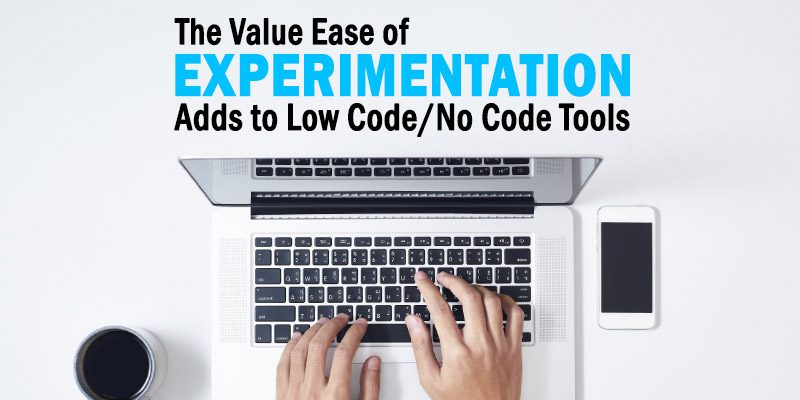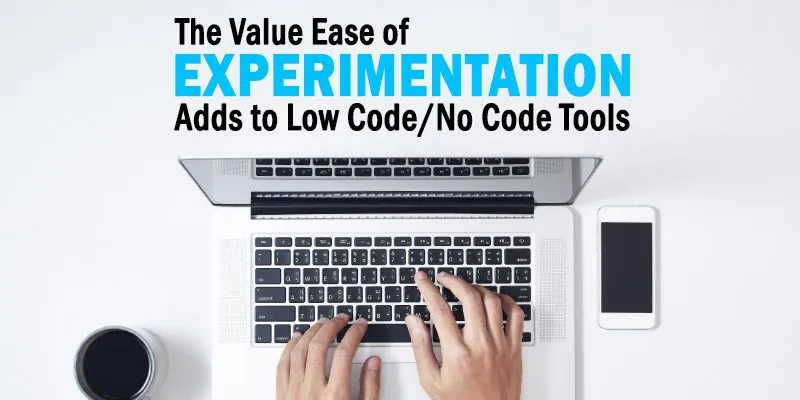The Value Ease of Experimentation Can Add to Low-Code/No-Code Tools
Blog: Solutions Review - Business Process Management

As part of Solutions Review’s Premium Content Series—a collection of contributed columns written by industry experts in maturing software categories—Nishant Patel, the co-founder and CTO at Contentstack, explains how ease of experimentation might be one of the most valuable benefits a company can get from using low-code/no-code tools.
 Entrepreneurs and business owners are hypothesis testers. They have an idea, build it, share it, get feedback, and adapt or rebuild it. Anything that helps streamline that process is essential. Gartner predicted that “by 2024, low-code application development will be responsible for more than 65 percent of application development activity.” There are a lot of reasons for this increasing popularity. Speed to market is probably most commonly cited; leveling the coding playing field is another big draw.
Entrepreneurs and business owners are hypothesis testers. They have an idea, build it, share it, get feedback, and adapt or rebuild it. Anything that helps streamline that process is essential. Gartner predicted that “by 2024, low-code application development will be responsible for more than 65 percent of application development activity.” There are a lot of reasons for this increasing popularity. Speed to market is probably most commonly cited; leveling the coding playing field is another big draw.
One that underlines both those benefits and more is the ease of experimentation. You can build an app quickly, get it out there, and see how people perceive it. If you get traction, you learn from it and spend resources on building the real deal. Or, and this is becoming increasingly more feasible, you develop on top of your low-code/no-code (LC/NC) solution until it is impossible to tell the difference between it and a full-stack app.
These tools turn what was once a multi-month process into a hypothesis testing machine and empower anyone, from marketers to CEOs to solo entrepreneurs, to become app developers. Here are three ways ease of experimentation might be the number one benefit of LC/NC tools.
Stakeholders Become Builders
Imagine you’re a marketer at an enterprise tech brand. You want to add a new feature to your product, but the development backlog is too long. Besides, you’re not sure the new feature will work. This happens all the time. In the past, stakeholders would wait or abandon their plans because product development was stuck behind an arcane firewall of requests and approvals. In other words, building from scratch was too difficult and frustrating to consider.
But today, those same stakeholders can iterate in minutes. LC/NC systems are designed for approachability. This means business stakeholders can unblock traditional paths of power and, in turn, get faster and more flexible when trying new things.
That said, these apps aren’t silver bullets. You can’t rebuild Uber on a platform like Wix or Bubble. Instead, you can create something like the first app Uber founder Travis Kalanik built to test Uber—a button on the screen that said: “Send a Car.” When users pressed it, they entered their address information, and a human dispatcher received a message and sent the car. That’s right: Uber used the old Wizard of Oz trick of the man behind the curtain. And look at them now.
In an LC/NC world, you don’t have to wait for an entire Uber app. You can make a button that does one thing surprisingly well. You can steer the product managers towards your vision when you prove the project has legs. LC/NC gives you the ammunition you need to help them make the call.
Coders Become Faster
Some coders consider LC/NC cheating. It’s not.
The hardest part of coding an entire app is understanding how the pieces fit together holistically. The back end and API need to talk to the front end. The business logic has to be coded into existence, and user testing is paramount. But coders are slowly turning towards LC/NC as a quick way to get the point across. With an LC/NC solution, you can have a new feature on your CEO’s desk in a day instead of a month. You can cut development costs and time by simply building instead of planning. While this is dangerous when it comes to “finished” apps, it’s a godsend when running a test.
For example, before Apple’s first Newton message pad was launched, the developers built model devices out of wood. They carried them around, tried to take notes on them (using little slips of paper), and imagined just what this product would become. The devices might not have worked, but getting a sense of how they could be used proved vital to the building and convincing process.
LC/NC is that block of wood—turbocharged. It looks and feels like the actual app and has most of the features. The only thing missing? The full-stack headache.
Customers Feel Essential
In many situations, your client needs something done quickly and cheaply. This, as we all know, was a recipe for disaster. Now it’s an opportunity for relationship building.
As I mentioned, entrepreneurs and business owners are hypothesis-testing machines. Their customers are the variables that go into that hypothesis. Internally, you may believe your customer wants X when they want Y. And customer surveys and interviews can get into their minds and hearts, but not necessarily real-world applications. How do you balance the must-haves vs. nice-to-haves without spending hundreds of thousands on development?
LC/NC makes your customers feel listened to and needed. You can consider their input instantly and report back. With an LC/NC solution, you can change everything from button placement to color. You can update the app accordingly when new information comes in from the field. Your customers think you are magical, and, in the end, you fill in the space between X and Y without having to activate your developers.
In this case, LC/NC apps may eventually become the ultimate customer service tools. Building from scratch is great, but you know what’s better? Feeling confident in your product ideas because you have some real-world proof to back them up.
Don’t hold yourself back with monolithic code and old thinking. Use LC/NC tools to promote ease of experimentation, turn internal stakeholders into builders, help developers move faster, and infuse customer ideas into your product hypothesis cycle. Watch your culture of innovation grow as a result.
The post The Value Ease of Experimentation Can Add to Low-Code/No-Code Tools appeared first on Best BPM Tools, Vendors, Software and BPMS.
